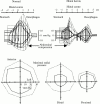The effect of hiatus hernia on gastro-oesophageal junction pressure
- PMID: 10075953
- PMCID: PMC1727465
- DOI: 10.1136/gut.44.4.476
The effect of hiatus hernia on gastro-oesophageal junction pressure
Abstract
Background: Hiatus hernia and lower oesophageal sphincter hypotension are often viewed as opposing hypotheses for gastro-oesophageal junction incompetence.
Aims: To examine the interaction between hiatus hernia and lower oesophageal sphincter hypotension.
Methods: In seven normal subjects and seven patients with hiatus hernia, the squamocolumnar junction and intragastric margin of the gastro-oesophageal junction were marked with endoscopically placed clips. Axial and radial characteristics of the gastro-oesophageal junction high pressure zone were mapped relative to the hiatus and clips during concurrent fluoroscopy and manometry. Responses to inspiration and abdominal compression were also analysed.
Results: In normal individuals the squamocolumnar junction was 0.5 cm below the hiatus and the gastro-oesophageal junction high pressure zone extended 1.1 cm distal to that. In those with hiatus hernia, the gastro-oesophageal junction high pressure zone had two discrete segments, one proximal to the squamocolumnar junction and one distal, attributable to the extrinsic compression within the hiatal canal. Inspiration and abdominal compression mainly augmented the distal one. Simulation of hernia reduction by algebraically summing the proximal segment pressures with the hiatal canal pressures restored normal maximal pressure, radial asymmetry, and dynamic responses of the gastro-oesophageal junction.
Conclusions: Hiatus hernia reduces lower oesophageal sphincter pressure and alters its dynamic responsiveness by spatially separating pressure components derived from the intrinsic lower oesophageal sphincter and the extrinsic compression of the oesophagus within the hiatal canal.
Figures






Comment in
-
The hiatus hernia slides back into prominence.Gut. 1999 Apr;44(4):449-50. doi: 10.1136/gut.44.4.449. Gut. 1999. PMID: 10075944 Free PMC article. No abstract available.
-
Vector manometry and LOS dynamics.Gut. 2000 May;46(5):740. doi: 10.1136/gut.46.5.740. Gut. 2000. PMID: 10836855 Free PMC article. No abstract available.
References
Publication types
MeSH terms
Grants and funding
LinkOut - more resources
Full Text Sources
Medical
